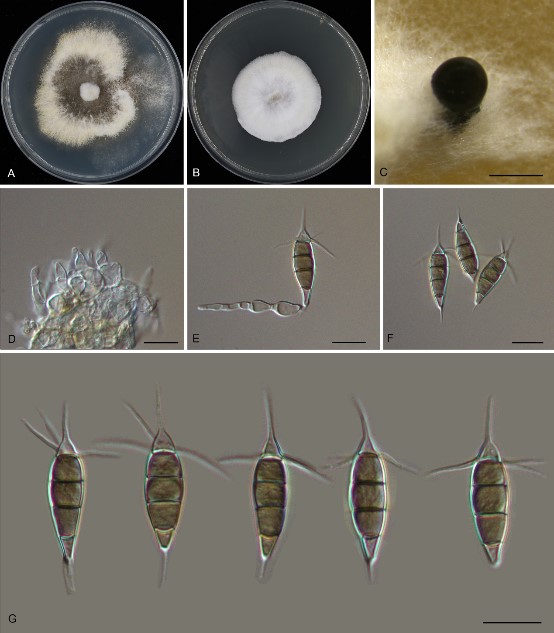Pestalotiopsis guizhouensis N. Jiang, in Jiang, Voglmayr, Xue, Piao & Li, Microbiology Spectrum: 10.1128/spectrum.03272-22, 15 (2022)
Index Fungorum number: IF 843389; MycoBank number: MB 843389; Facesoffungi number: FoF 11696;
Etymology – named after the collection site of the type specimen, Guizhou Province.
Pathogenic to host leaves. Asexual state: Conidiomata in culture sporodochial, aggregated or solitary, erumpent, pulvinate, black, 100–400 μm diam., exuding black conidial masses. Conidiophores indistinct, usually reduced to conidiogenous cells. Conidiogenous cells hyaline, smooth, ampulliform to spherical, annelidic, 6–17.5 × 3–6 μm, mean ± SD = 9.6 ± 4.3 × 4.5 ± 0.9 μm. Conidia fusoid, straight or slightly curved, 4-septate, smooth, slightly constricted at the septa, (21–)22.5–25.5(–26.5) × (7–)7.5–8.5(–9.5) μm, mean ± SD = 23.8 ± 1.6 × 8.1 ± 0.6 μm (n = 50), L/W = 2.4–3.5; basal cell obconic with a truncate base, thin-walled, hyaline or pale brown, (2.5–)3.5–5.5(–6.5) μm; median cells 3, trapezoid or subcylindrical, concolourous, pale bown to brown, thick-walled, the first median cell from base (4.5–)5–7(–7.5) μm long, the second cell (3.5–)4.5–5.5(–6) μm long, the third cell (4–)4.5–5.5(–6) μm long, together (13–)14.5–17.5(–18) μm long; apical cell conic with an acute apex, thin-walled, hyaline, (2.5–)3–4.5(–5) μm long; basal appendage single, unbranched, tubular, centric, straight or slightly bent, (2–)3.5–6.5(–8) μm long, mean ± SD = 4.8 ± 1.5 μm; apical appendages 3–4, unbranched, tubular, attenuate towards the apex, centric, straight or slightly bent, (7–)8–12(–15) μm long, mean ± SD = 10.2 ± 2 μm. Sexual morph unknown.
Culture characters – Colonies on MEA flat, spreading, with flocculent aerial mycelium and entire edge, white, reaching a 35-mm diameter after 10 days at 25°C, sterile; on PDA, flat, spreading, with flocculent aerial mycelium and irregular edge, sienna, reaching a 55-mm diameter after 10 days at 25°C, forming black conidiomata with black conidial masses.
Material examined – China, Guizhou Province, Zunyi City, Suiyang County, Kuankuoshui Natural Reserve, on diseased leaves of Cyclobalanopsis glauca, 23 November 2019, Dan-ran Bian (holotype CAF 800046; ex-holotype culture CFCC 54803); ibid., CFCC 57364.
Distribution – China
Sequence data – ITS: ON007035 (ITS1/ITS4); tef1: ON005052 (EF1-728F/EF2); tub2: ON005063 (Bt2a/Bt2b)
Notes – Two isolates of Pestalotiopsis guizhouensis from Cyclobalanopsis glauca clustered into a distinct clade phylogenetically close to P. cyclobalanopsidis (Fig. 1). However, P. guizhouensis differs from P. cyclobalanopsidis by conidial shape (straight or slightly curved conidia in P. guizhouensis versus distinctly curved conidia in P. cyclobalanopsidis).

Fig. 13. Morphology of Pestalotiopsis guizhouensis (CFCC 54803). A. Colony on PDA after 10 d at 25 °C; B. Colony on MEA after 10 d at 25 °C; C. Conidioma formed on PDA; D, E. conidiogenous cells giving rise to conidia; F, G. conidia. — Scale bars: C = 300 μm; D–G = 10 μm.
